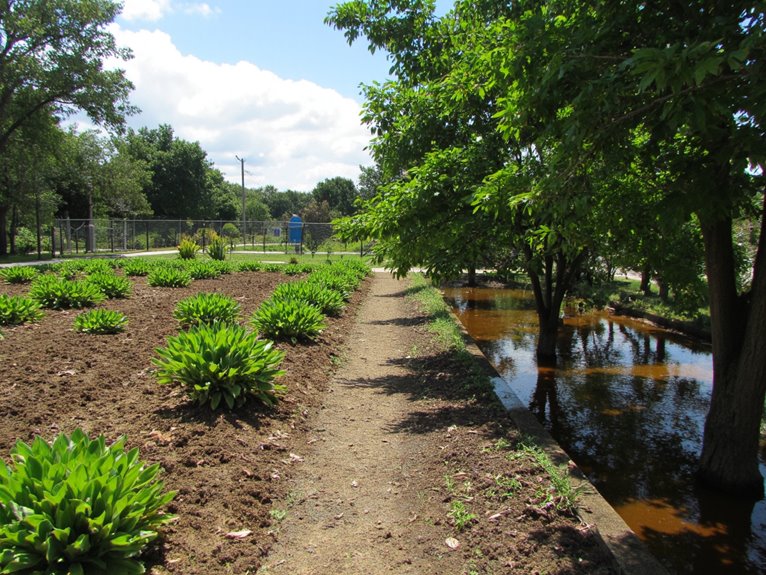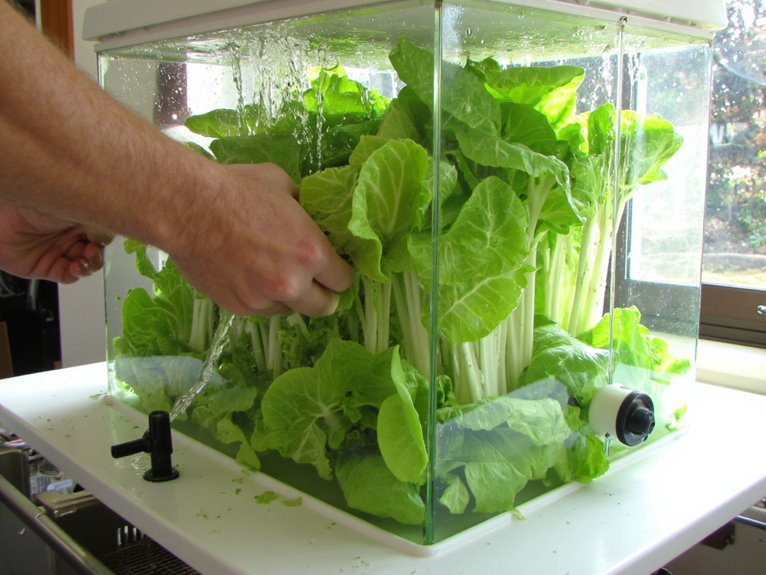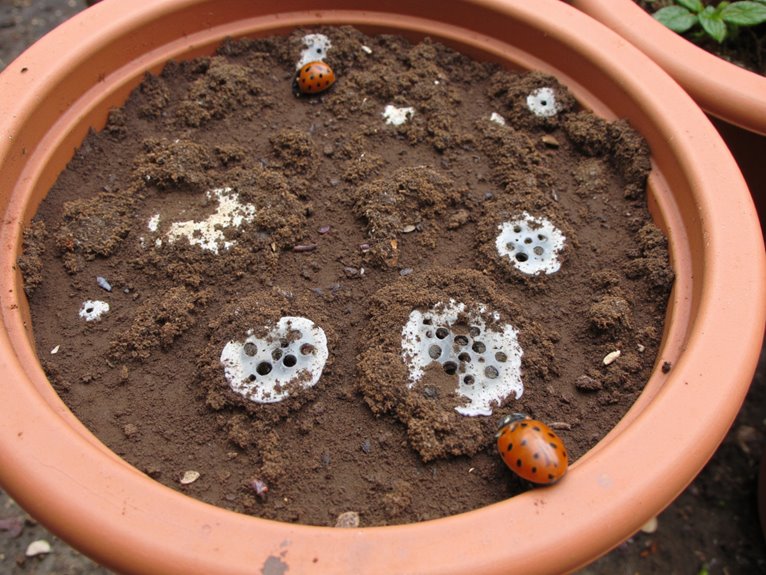Ebb and Flow Hydroponic Systems: Flood and Drain Growing Method Explained
Ebb and flow hydroponics mimics natural watering by flooding plant roots periodically before draining them. This cycle guarantees plants get both water and oxygen, preventing root rot while promoting growth. You’ll need a reservoir, pump, timer, and overflow system to manage the water levels automatically. Many gardeners grow herbs and lettuce successfully with this method because it supports diverse crops efficiently. If you’re interested in setting up your own system, there are additional tips on optimizing nutrient delivery and plant spacing available.
Notable Insights
- Ebb and Flow hydroponics floods plant roots periodically then drains to provide oxygen.
- Systems use reservoirs, pumps, timers, and overflow fittings for controlled cycles.
- Method mimics natural rainfall, supporting diverse plants with efficient nutrient uptake.
- Regular drainage prevents root rot and promotes healthy growth in non-waterlogged conditions.
- Easy to scale and maintain, offering high yields with minimal long-term setup costs.
Understanding the Basics of Ebb and Flow Hydroponics
Whether you’re new to hydroponics or looking to expand your gardening skills, understanding ebb and flow systems can open new possibilities for growing plants efficiently. These systems deliver nutrient solutions directly to plant roots through periodic flooding and draining, supporting a wide range of plant varieties from herbs to vegetables. The process guarantees consistent hydration while allowing excess water to drain back, preventing root saturation. This method also promotes healthy growth by maintaining ideal oxygen levels in the growing medium. With proper setup, ebb and flow systems offer flexibility for different scales of gardening. By mastering nutrient solution ratios and cycle timing, growers can enhance plant performance and yield. Similar to how mycorrhizal fungi enhance root development in premium growing mediums, the beneficial microorganisms in quality substrates can significantly improve nutrient uptake in hydroponic systems. root aeration through draining phases is a key factor that distinguishes this system from other hydroponic methods.
How the Flood and Drain Process Works
Once you understand how the flood and drain process works, you’ll see why it’s a popular choice for hydroponic growers—this method mimics natural soil cycles while delivering precise hydration and oxygenation to plant roots. During each cycle, a nutrient-rich solution floods the root zone, enabling efficient nutrient absorption through saturation. Flood timing is essential; too long, and roots risk suffocation, while too short limits intake. After draining, air returns to the medium, supporting healthy respiration. This balance guarantees ideal conditions for growth, with flood and drain intervals tailored to plant needs. The result? A dynamic environment that supports robust development while minimizing stress on your plants.
By selecting the right inert growing medium, growers can better control balance between air and water, ensuring optimal conditions for root health and nutrient uptake.
Essential Components of an Ebb and Flow System
Understanding how the flood and drain process supports plant growth makes it easier to see what you’ll need to build an ebb and flow system—think of it as creating the ideal rhythm for your plants to thrive. At the heart of this method is a reliable pump selection that moves nutrient solution efficiently between reservoirs and grow trays. Maintaining the right nutrient balance guarantees plants receive maximum nourishment without overwatering. The system’s dual function as both a watering mechanism and an oxygenator ensures roots get complete nutrition while avoiding waterlogged conditions that could lead to root rot.
| Component | Function | Key Considerations |
|---|---|---|
| Reservoir | Stores nutrient solution | Opaque, appropriately sized |
| Pump | Moves water during flood cycles | Sufficient power for system height |
| Timer | Controls flood/drain timing | Programmable for multiple cycles |
Add overflow fittings to regulate water levels and guarantee complete drainage. Pair this with air stones to oxygenate the solution between floods, supporting strong root development. Regular monitoring of pH balance prevents nutrient lockout and maximizes absorption rates throughout each flood and drain cycle.
Key Advantages of This Hydroponic Method
Whether you’re growing herbs or harvesting tomatoes, the flood and drain method offers a smart way to nurture plants with precision. This system supports crop diversity by allowing different plant species to thrive in the same setup through customizable growing media and environmental conditions. With nutrient management at its core, flood and drain guarantees roots receive ideal hydration and nourishment without over-saturation. The periodic flooding cycle mimics natural rainfall patterns, while draining phases promote oxygen flow for healthier root systems. This balance enhances nutrient uptake efficiency, resulting in faster growth and higher yields across a wide range of crops. Combined with low maintenance needs and scalable design, the flood and drain method provides gardeners with a reliable, cost-effective way to grow abundant, flavorful plants year-round.
Maintaining Root Health Through Aeration
Although the flood and drain system might seem simple, its true power lies in how it keeps your plants’ roots healthy by giving them regular breaks from being constantly submerged. During drainage, root oxygenation occurs as air replaces the nutrient solution, preventing anaerobic conditions that foster disease. This aeration also removes waste gases, improving nutrient uptake efficiency. With disease prevention in mind, the wet-dry cycle inhibits fungal pathogens that thrive in waterlogged environments. By mimicking natural cycles, this method guarantees your roots stay both hydrated and oxygenated—perfect for vigorous growth.
Customizing Your Ebb and Flow Setup
The flood and drain method’s natural cycles keep roots healthy by giving them air breaks, which is why tailoring your setup to match your plants’ specific needs makes sense. Pump timers let you customize flood durations, while reservoir size matters for nutrient delivery. Dark tubing and watertight fittings help with overflow management and prevent algae. Container selection affects root space, and media types influence water retention.
| Component | Key Considerations | Best Practice |
|---|---|---|
| Pump Timers | Cycle length & frequency | Match to plant stage and growth rate |
| Reservoir Size | Volume for system & plants | Allow 20-30% extra for water expansion |
| Tubing Fittings | Algae prevention & leaks | Use dark tubing with secure connections |
Reservoir placement, nutrient solution changes, and media sterilization all contribute to a successful ebb and flow setup.
Frequently Asked Questions
Can Ebb and Flow Systems Be Used With Aquaponics?
Yes, ebb and flow systems work great with aquaponics — they’re compatible and offer advantages like improved root oxygenation and better nutrient distribution. You just need to manage the balance between fish and plants carefully.
What’s the Ideal Water Temperature Range for This Method?
What’s the ideal water temperature range for this method? Best conditions sit between 70°F to 75°F (21°C to 24°C), with a sweet spot near 71.6°F (22°C). Keep it stable, and you’ll keep your plants happy and healthy!
How Often Should I Change the Nutrient Solution?
You should change the nutrient solution every 7 to 14 days, adjusting based on nutrient timing and plant stage. Solution monitoring includes checking ppm levels, pH, and top-offs daily. Clean the reservoir each change to prevent buildup and guarantee healthy growth.
Are There Any Specific Plant Varieties That Work Best?
You should focus on basil varieties and lettuce types, which thrive in ebb and flow systems. Their shallow roots and need for regular watering make them perfect fits, plus they respond well to the nutrient cycling.
Can This System Support Large-Scale Commercial Farming?
Yes, the ebb and flow system can support large-scale commercial farming due to its scalability and commercial viability. It offers consistent yields, efficient resource use, and flexibility for expansion—key factors for growing operations.
On a final note
As you commence your hydroponic journey, remember that patience and attention to detail will yield the best results. With proper care, an ebb and flow system can deliver abundant harvests while offering a rewarding way to connect with nature. Keep learning, experimenting, and enjoying the process—your garden will thank you for it.






